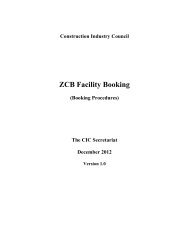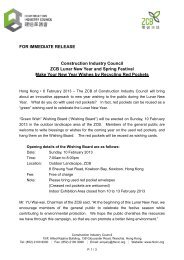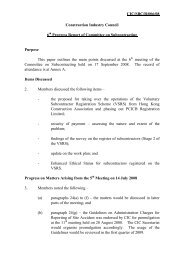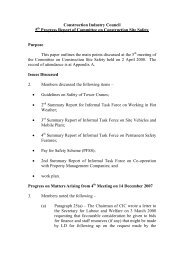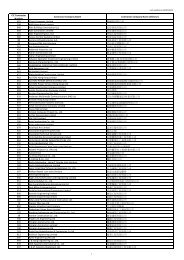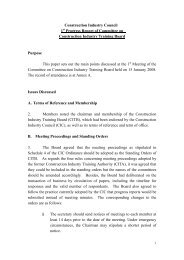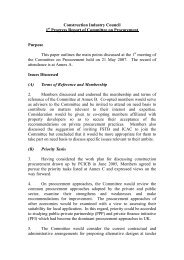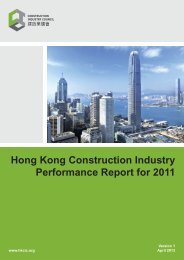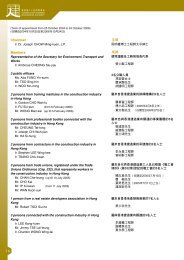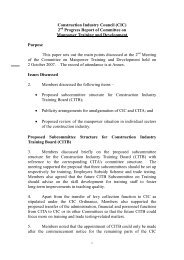Document title - Construction Industry Council
Document title - Construction Industry Council
Document title - Construction Industry Council
Create successful ePaper yourself
Turn your PDF publications into a flip-book with our unique Google optimized e-Paper software.
<strong>Construction</strong> <strong>Industry</strong> <strong>Council</strong><br />
3 rd Progress Report of Committee on Procurement<br />
Purpose<br />
This paper outlines the main points discussed at the 3 rd meeting of<br />
the Committee on Procurement held on 8 October 2007. The record of<br />
attendance is at Annex.<br />
Issues Discussed<br />
2. Members discussed the following issues –<br />
- innovative procurement arrangements adopted in<br />
development projects in Macau;<br />
- design and build (D&B) projects of Arch SD; and<br />
- EPD’s experience on design, build and operate (DBO)<br />
contracts.<br />
Progress on Matters Arising from 2 nd Meeting on 31 July 2007<br />
3. Members noted the following<br />
Paragraph 14(a)<br />
Innovative procurement arrangements adopted in Macau would be<br />
discussed in later parts of the meeting.<br />
Paragraph 14(b)<br />
The discussion of public private partnership was being arranged.<br />
Innovative Procurement Arrangements<br />
Adopted in Development Projects in Macau<br />
4. Messrs Ian Cocking and Brian Downie of Minter Ellison gave an<br />
overview of the innovative procurement arrangements adopted in the<br />
recent development projects in Macau. The market in Macau was<br />
characterized by the imperative for speed, developers that were<br />
unfamiliar with the local construction market and had limited or no<br />
internal design and construction capability, large project size, labour and<br />
-1-
esources constraints as well as desire for flexibility in changing the<br />
design in the course of construction.<br />
5. A number of innovative procurement approaches were adopted to<br />
meet these challenges. The D&B approach was used in Sands Macau to<br />
reduce the employer’s risk, make better use of contractor’s expertise and<br />
fast track construction. On the other hand, the costs might be higher<br />
because of higher risk placed on the contractor. The owner also lost<br />
control over the design. The design management approach was used in<br />
the Venetian Macao whereby the owner employed a group of design<br />
consultants and a construction manager for managing the construction<br />
contracts. In comparison to D&B, the owner could exercise better control<br />
on the design and there would be less risk on the contractors. On the<br />
downside, there was less certainty on price and completion day and<br />
increased project management cost.<br />
6. Wynn Macao and Crown Macau were delivered through<br />
guaranteed maximum price (GMP) contracts under which contractors<br />
were reimbursed up to the GMP for the cost of work and contractors’ fee.<br />
The GMP could be adjusted to reflect change of project requirements.<br />
The parties would share savings but contractors would have to absorb<br />
cost beyond the GMP. This arrangement provided incentive for cost<br />
saving but increased the contractor’s exposure to incurring costs above<br />
the GMP. It was expected that the competitive environment, the<br />
bargaining power of key contractors and their reluctant to incur high<br />
tendering cost would continue to drive innovations in procurement<br />
arrangements in Macau.<br />
7. In response to the observation that the design management<br />
arrangement could lead to high project cost due to lack of a single point<br />
of responsibility, Mr Brian Downie suggested that the additional expense<br />
could be offset by cost saving resulting from splitting construction works<br />
into suitable packages. A Member concurred that considerably cost<br />
savings could be achieved by investing in project management to manage<br />
the interfaces of works packages.<br />
D&B Projects of Arch SD<br />
8. Arch SD had delivered about 20 Government building projects<br />
using the D&B approach since 1991. Nine on-going projects were being<br />
undertaken and one was being planned. The project portfolio<br />
encompassed a large variety of buildings including hospitals, government<br />
quarters, government offices, police stations and sports grounds.<br />
-2-
9. The D&B approach established a single point of responsibility<br />
through entrusting both detailed design and construction to contractors<br />
thus avoiding claims arising from design problems. The single point of<br />
responsibility resulted in greater certainty in the final contract cost.<br />
Considerable time saving could also be achieved through undertaking the<br />
detailed design and construction in parallel which would also facilitate<br />
more timely adjustment to building design to suit changes of user<br />
requirements. In terms of quality, the use of flexible Employer’s<br />
Requirements (ER) in tendering provided room for contractors to achieve<br />
quality enhancements and deliver added value through innovations in<br />
design and construction.<br />
10. The procurement process under the D&B approach usually<br />
started with prequalification of tenderers. The prequalified tenderers<br />
would tender on the basis of performance based requirements. The tender<br />
assessment process would take into account both quality and cost (in<br />
contrast to the conventional approach which was mainly cost driven).<br />
The supervision efforts for the D&B approach was only 25% in<br />
comparison to conventional approach since the onus of checking was<br />
placed on contractors.<br />
11. The suitability of adopting the D&B approach would hinge on<br />
several prerequisites including the need to meet programme that was not<br />
possible under the conventional approach, established outsourcing<br />
strategies, clear definition of user requirements, availability of competent<br />
bidders, sufficient project size to cover the resources spent on<br />
prequalification and tendering as well as end user endorsement and cooperation.<br />
12. Responding to Members’ enquiries, Arch SD advised that<br />
consultants and contractors had geared up for the D&B mode of project<br />
delivery. Arch SD did not have clear preference for the D&B approach<br />
and would select the appropriate approach based on requirements of<br />
individual projects.<br />
13. While D&B approach would lead to greater certainty in the final<br />
contract sum, there were doubts on whether the process could lead to the<br />
best design if sufficient time were not allowed for tendering. As such, it<br />
was suggested that consideration should be given to extending the<br />
tendering period to 10 to 12 weeks for contracts with value exceeding $10<br />
billion. The possibility of integrating D&B with GMP should also be<br />
considered.<br />
-3-
14. Government should consider making direct payment to designers<br />
engaged in supervision work since employment by contractors could put<br />
them in awkward positions. While D&B contracts would involve high<br />
tendering cost, Government was not prepared to reimburse such costs to<br />
unsuccessful tenderers. Members agreed that CIC could take up this<br />
issue with DEVB if there was consensus on the reimbursement of<br />
tendering costs.<br />
EPD’s Experience on DBO Contracts<br />
15. EPD decided to adopt the DBO approach when it took over the<br />
responsibility for development and management of a new generation of<br />
waste management facilities including landfills, refuse transfer stations<br />
(RTS) and chemical waste treatment centre (WTC) because the traditional<br />
procurement arrangements used in earlier contracts could not attract<br />
experienced operators. Between 1988 and 2000 EPD procured 16 DBO<br />
contracts. Under the DBO approach, contractors were responsible for the<br />
design, construction and operation of the waste management facilities on<br />
long-term basis (45 years for landfill contracts and 17 years for RTS<br />
contracts). DBO contracts specified the performance and environmental<br />
requirements, such as throughput and odour control. Contractors were<br />
free to choose the appropriate design and mode of operation for achieving<br />
compliance.<br />
16. On advantages, DBO contracts generated long-term sources of<br />
income that attracted international waste management companies. Long<br />
contract durations were also found to be conducive to the adoption of<br />
rational and collaborative approach by the contracting parties. Moreover,<br />
allocation of operational responsibilities to contractors gave them<br />
incentives for adopting integrated solutions to achieve value for money.<br />
An example was the Island West Transfer Station in which the<br />
contractors proposed a cavern layout which was much more compact than<br />
the tender design.<br />
17. On limitations, long-term contracts could restrict the employers’<br />
options in making major changes. Such changes could be made only<br />
through protracted negotiations. Moreover, contractors might propose<br />
technical solutions that complied with the performance requirements but<br />
were not in line with the employers’ preferences.<br />
18. Despite these limitations, EPD had recently reviewed the DBO<br />
approach and found that it had achieved the original goals devised in<br />
-4-
19. Responding the Members’ enquiries, EPD indicated that with the<br />
expiry of first generation of RTS contracts, new contracts would be<br />
procured through the DBO approach and would incorporate<br />
improvements such as milestone payment for the capital cost and direct<br />
payment by EPD to independent consultants engaged in checking<br />
compliance with performance criteria. International firms usually<br />
partnered with local firms in bidding for DBO contracts. While EPD’s<br />
contractors employed a significant number of local staff, the adoption of<br />
advanced technology still depended on overseas support.<br />
CIC Secretariat<br />
November 2007<br />
-5-
Annex<br />
Committee on Procurement<br />
3 rd Meeting held at 2:30 pm on 8 October 2007<br />
in Conference Room 1201, Murray Building<br />
Record of Attendance<br />
Present<br />
Mr Russell Black<br />
Mr James Chiu<br />
Mr Thomas Ho<br />
Mr LAM Wo-hei<br />
Mr S S Lee<br />
Mr Conrad Wong<br />
Ms Susanna Wong<br />
Mr K M Yeung<br />
Mr C K Lau<br />
Mr CHEUNG Lung-hing<br />
Mr Hugh Wu<br />
Mr Ian Cocking<br />
Mr Colin Jesse<br />
Ms. Margaret Coates<br />
Mr Edward Lee<br />
Chairman<br />
Housing Department<br />
Housing Department<br />
Hong Kong Federation of Electrical and<br />
Mechanical Contractors<br />
Hong Kong <strong>Construction</strong> Site Workers<br />
General Union<br />
Macao Studio City<br />
Minter Ellison Lawyers<br />
Evans and Pecks (HK) Ltd.<br />
CLP Power Hong Kong Ltd.<br />
Development Bureau<br />
Absent with apologies<br />
Mr James Blake<br />
Mr Francis Bong<br />
Dr Andrew Chan<br />
Ms Teresa Cheng<br />
Mr T T Cheung<br />
Mr Michael Green<br />
Mr Billy Wong<br />
-6-
Ms Ada Fung representing Permanent Secretary for<br />
Transport and Housing (Housing)<br />
Prof. Mohan Kumaraswamy University of Hong Kong<br />
Mr Hugh Boyd<br />
Hong Kong <strong>Construction</strong> Association<br />
In attendance<br />
<strong>Construction</strong> <strong>Industry</strong> <strong>Council</strong> Secretariat<br />
Mr K H Tao<br />
Mr Solomon Wong<br />
Chief Assistant Secretary for Development<br />
(Works) 1<br />
Assistant Secretary for Development (Works)<br />
Public Works Systems Administration 1<br />
For discussion of “Innovative Procurement Arrangements Adopted<br />
in Development Projects in Macau”<br />
Mr Brian Downie<br />
Minter Ellison Lawyers<br />
For discussion of “Design & Build Projects of Arch SD”<br />
Ms Uson Chung )<br />
Mr Michael Chong )<br />
Architectural Services Department<br />
For discussion of “EPD’s Experience on DBO Contracts”<br />
Mr Lawrence Lau<br />
Environmental Protection Department<br />
-7-



